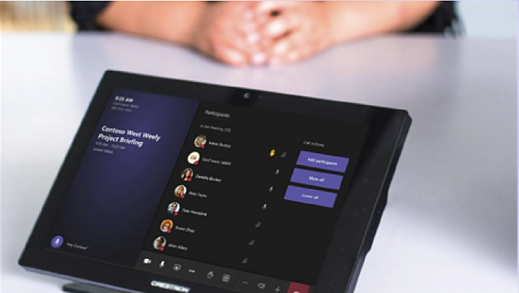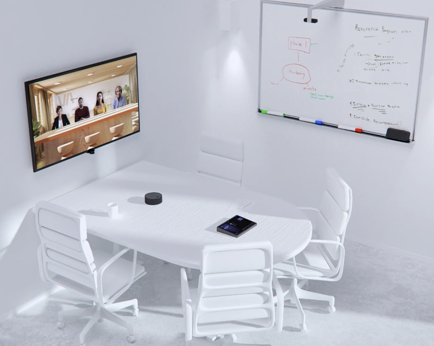We answer all of your questions about this new way to collaborate, meet with, and communicate with people while working remotely.
Working mostly remote had its perks, and everyone has an opinion on what will happen moving forward, but in a lot of places, businesses are returning to offices. That doesn’t mean that everyone will go back to the office, but aren’t we all at least a little more aware of how remote work can impact collaboration and meetings?
So what do you do when part of your team works remotely, but the other part of the team is in the office?
Or what if you have teams at multiple sites that need to work together?
What do you do when you need to have multiple members of your team on a call with a remote customer?
How about having a team meeting when the boss needs to call in from out of town?
How can you make being on a call with all the people around you more bearable when you hear everything in real-time and on delay through the call?
Basically, how can you effectively connect an entire office team without actually having everyone in the office? You need a solution where everyone can be seen, heard, and fully participate from anywhere.
In comes a Microsoft Teams Room.
Let’s dive deep into the biggest FAQs of Microsoft Teams Rooms.
What is a Microsoft Teams Room?
A Microsoft Teams Room creates a complete meeting experience that brings HD video, audio, and content sharing to meetings of all sizes, for participants both in the room and online.
Why should you use a Microsoft Teams Room?
We’ve all figured out by now how hard it is to collaborate, meet with, and communicate with people while working remotely. As the aftermath of these past two years sets in and people become more mobile, organizations will need to adapt office spaces and technology to meet the needs of a hybrid workforce. And for all those people who worked remotely before? A Microsoft Teams Room will dramatically improve the way that they can interact with their colleagues in the office.
What is the difference between a Microsoft Teams Room and a conference room phone?

Huddling around a phone in the middle of the table and trying to make sure you hit the mute button in time isn’t fun for anyone. And the more people there are, the more problems you find. Are people too far from the mic? How is the newest remote employee supposed to know who everyone is? With a Microsoft Teams Room, you can see everyone in the room. Strategically placed mics and mic extenders make sure that everyone can be heard. And a presentation that can simultaneously be displayed on the TV in the conference room and on the displays of the remote employees means less confusion for everyone.
Why a Microsoft Teams Room instead of Zoom, Cisco Webex, etc.?
While each of these solutions offers pretty much the same thing, a Microsoft Teams Room is more secure because it’s in your Microsoft environment. And did we mention they’re already integrated into your Microsoft Environment? You already know and understand the Team interface, so learning to use a Microsoft Teams Room is simple and intuitive.
Who should use a Microsoft Teams Room?
People looking to get with the times and replace their old conference room phones, offices that are experiencing the hardships of a hybrid workforce, and/or you want to showcase how you have the newest and up-to-date technology (take that Dennis from that company that chose our competitor because we were using last year’s model)
Where should you put a Microsoft Teams Room?

There are three different layouts available depending on the size of the conference room. You will want to choose the configuration that best fits your room size, so take a hint from Goldilocks and make sure you get the solution that’s just right for your room. (But please don’t go breaking into bears’ homes in the woods. I don’t care if their porridge smells wonderful, the chairs are perfect, or the beds are cozy. Just don’t do it.)
Where would you get the right hardware for a Microsoft Teams Room?
There are many different vendors that offer Teams Room equipment options. Whoever installs your Teams Room could help you decide which hardware will work best for you. For example, Summit Technology uses Logitech hardware because they offer high-quality hardware that is easy to use and looks clean and professional.
How much does a Microsoft Teams Room cost?
Hardware costs can vary by vendor, availability, and layout options. The installation cost varies by room size and network complexity. There is a Microsoft Teams Room that fits your needs, and whether you need to know so you can budget in the expense or if you just want to make sure you’re making a sound investment, discuss with an experienced vendor, like Summit Technology, to make sure you’re getting a great setup at a great price point.
Who would install a Microsoft Teams Room?
Your first thought might be Microsoft but that is not the case! Microsoft will NOT be sending Adam from IT; you would have to hire a Microsoft Partner IT contractor like Summit Technology to do the job. We have technicians who are experienced in the physical setup of your actual conference room, a cabling team that can pull additional cable if your room isn’t quite ready, and Microsoft experts who will make sure your room is integrated into your existing Microsoft environment.
When can you get one?
Now!
Talk to us about how we can find you a solution that is Simple. Convenient. Secure.
If you still have questions about Microsoft Teams Rooms, you can contact us at learnmore@greatservice.com or fill out our contact us form.



